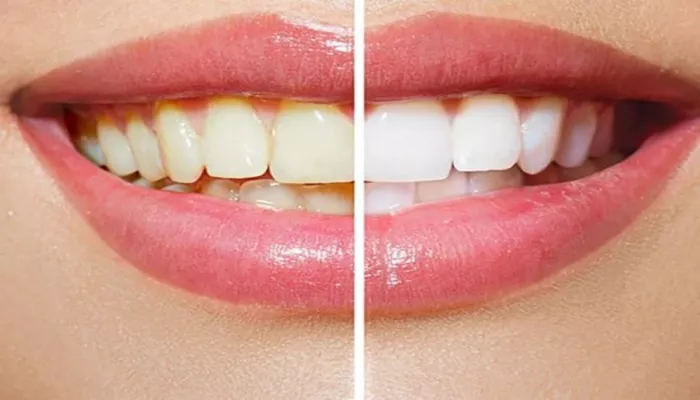Yellow teeth are a common concern for many people. Discolored teeth can affect your confidence and smile. While professional treatments in cosmetic dentistry are effective, many want to know how to reduce yellow teeth naturally. This article explains simple, factual methods to brighten teeth using natural techniques, while also emphasizing the importance of oral health, including prevention of gum disease.
What Causes Yellow Teeth?
Understanding why teeth turn yellow helps in choosing the right natural remedies. Yellowing can be caused by:
Poor Oral Hygiene: Plaque buildup and tartar cause teeth to appear yellow.
Food and Drinks: Coffee, tea, red wine, and certain foods stain teeth.
Smoking: Tobacco products discolor teeth over time.
Aging: Enamel thins with age, exposing the yellow dentin underneath.
Medications: Some antibiotics and other drugs can cause discoloration.
Genetics: Natural tooth color varies by individual.
Health Conditions: Conditions affecting enamel or dentin may lead to discoloration.
Natural Ways to Reduce Yellow Teeth
Maintain Good Oral Hygiene
Brushing and flossing regularly remove plaque and surface stains. Use a fluoride toothpaste and brush at least twice a day. Floss daily to remove debris between teeth. Proper hygiene helps prevent gum disease and keeps your smile bright.
Use Baking Soda
Baking soda is mildly abrasive and can remove surface stains. Mix a small amount with water to form a paste. Brush gently with it 1-2 times a week. Avoid overuse to protect your enamel.
Oil Pulling
This traditional method involves swishing coconut or sesame oil in your mouth for 10-15 minutes. Oil pulling may reduce plaque and bacteria, helping to whiten teeth naturally and improve gum health.
Eat Crunchy Fruits and Vegetables
Apples, carrots, and celery act like natural toothbrushes. Their crunchy texture helps scrub away surface stains and stimulate saliva production, which protects teeth from decay and gum disease.
Limit Staining Foods and Drinks
Reduce consumption of coffee, tea, soda, and red wine. When you do consume them, rinse your mouth with water afterward to minimize staining.
Use Hydrogen Peroxide Mouth Rinse
Hydrogen peroxide is a natural bleaching agent. Dilute it with equal parts water and use as a mouth rinse occasionally. Do not swallow, and avoid overuse to prevent irritation.
Try Activated Charcoal
Some people use activated charcoal powder to remove stains. Brush gently with charcoal 1-2 times a week. It may help absorb toxins and reduce yellowing, but more research is needed.
Avoid Smoking and Tobacco Use
Tobacco stains teeth deeply and contributes to gum disease. Quitting smoking benefits both your oral health and overall well-being.
Drink Plenty of Water
Water helps wash away food particles and bacteria. Staying hydrated supports saliva production, which naturally protects teeth and gums.
Diet and Nutrition for Healthy Teeth
Calcium and Vitamin D
These nutrients strengthen teeth and bones. Include dairy products, leafy greens, and fortified foods in your diet to support enamel health.
Limit Sugary Foods
Sugar feeds harmful bacteria that cause cavities and plaque buildup, leading to yellowing and gum disease.
Eat Foods Rich in Fiber
Fiber-rich foods help clean teeth and stimulate gums, improving oral hygiene naturally.
The Role of Cosmetic Dentistry in Yellow Teeth
While natural methods are helpful, sometimes professional care is necessary. Cosmetic dentistry offers treatments like professional teeth whitening, veneers, and bonding to enhance your smile safely and effectively.
Professional Teeth Whitening
Dental offices use stronger bleaching agents than over-the-counter products. Professional whitening provides faster, longer-lasting results and addresses deep stains.
Dental Veneers and Bonding
Veneers are thin porcelain shells that cover discolored teeth. Bonding uses tooth-colored resin to improve appearance. Both can be options if natural whitening isn’t enough.
Preventing Gum Disease While Whitening Teeth
Good gum health is essential before starting any whitening method. Gum disease can cause bleeding, inflammation, and tooth loss. Whitening products can irritate inflamed gums, so treatment of gum disease should come first.
Maintain Regular Dental Checkups
Professional cleanings remove tartar that brushing cannot. Your dentist will check for signs of gum disease and recommend the best whitening options based on your oral health.
When to See a Dentist About Yellow Teeth
If natural methods don’t improve your yellow teeth, or if you notice symptoms like bleeding gums, tooth sensitivity, or pain, see a dental professional. They can diagnose underlying causes such as enamel erosion or gum disease and provide tailored treatment.
Conclusion
Reducing yellow teeth naturally requires consistent oral hygiene, healthy diet choices, and lifestyle changes like avoiding tobacco. Methods like baking soda, oil pulling, and hydrogen peroxide rinses can help lighten teeth safely. However, addressing gum health and consulting a dentist ensures safe and effective results. When natural care is not enough, cosmetic dentistry provides advanced solutions to restore your bright smile.

